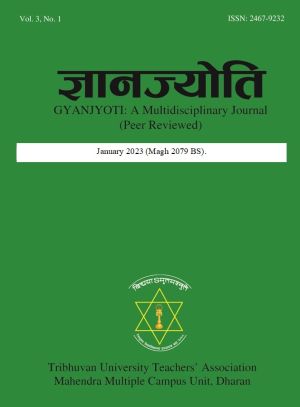Exploration of Nature in Śṛī Kṛṣṇa's Rāsa Līlā with Gopīs in the Śrimad Bhāgavata Mahāpurāṇa
DOI:
https://doi.org/10.3126/gyanjyoti.v3i1.53033Keywords:
Exploration, līlā, prakṛiti, puruṣa, rāsa, unionAbstract
The focus of this article is to explore Nature in rāsa līlā of Śṛī Kṛṣṇa with gopīs in the Śrimad Bhāgavata Mahāpurāṇa. The objective of this article is to explore rāsa līlā as a union of male and female for the creation and continuation of Nature of this world. In rāsa līlā, Śṛī Kṛṣṇa represents the entire male element (Puruṣa) of creation whereas the gopīs typify Prakṛiti, the female element. There is the union of Prakṛiti (Nature) and Puruṣa (consciousness) in the rāsa dance of Śṛī Kṛṣṇa līlā. To evaluate the rāsa līlā superficially, from the materialistic perspective is a problem of this study. The researcher incorporates Nature for the analysis of the rāsa līlā between Śṛī Kṛṣṇa and the gopīs. He has used theory of Immanuel Kant to explore Nature in rāsa līlā of Śṛī Kṛṣṇa with gopīs. The philosopher realizes divine being in the objects of Nature and argues that Nature is not different from divine being. It is based on the interpretation of critics and scholars in the rāsa līlā of Śṛī Kṛṣṇa. The findings of this investigation are to provide new perspective with evidences in the rāsa līlā of Śṛī Kṛṣṇa. It gives a new insight to readers about this divine dance. The main conclusion to be drawn from this research paper is that men and women are fragments and incomplete in themselves without union between them. There should be continuation of rāsa in different forms for the existence of humans and other creatures on earth.




